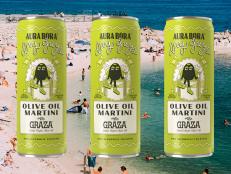What Are Sweet Proteins? And Are They a Good Substitute for Sugar?
I tried Oobli, the first company in the U.S. to use sweet proteins in its products.

Photo courtesy of Oobli
I’m a huge iced tea fan, but as a registered dietician, I don’t usually use my daily added sugar allowance in my beverages. As such, you’ll usually find me sipping on unsweetened beverages like iced or hot tea.
But sometimes the craving for sweetness still strikes, and I’ve tried a handful of lower sugar varieties – though oftentimes, even those are a bit too sweet for me.
However, I recently came across another alternative: sweet proteins, which are actually proteins – not sugar – that taste sweet, provide few calories and don’t trigger a rise in blood sugar or insulin.
Below you’ll find more information on what sweet proteins are, how they are derived and products that contain them.
What Are Sweet Proteins?
Sweet proteins evolved in plants that grow around the equator in tropical ecosystems like West Africa and Southeast Asia. They are a class of proteins that deliver a sugar-like sweetness but have the molecular structure and functionality of a protein; as such, they do not impact blood sugar levels.
“These plants produce fruits and berries that contain tiny amounts of proteins that taste thousands of times sweeter than sugar! But what makes these plants special is that they evolved these proteins to actually taste sweet like sugar. And that means they have no impact on blood sugar or the gut microbiome,” says Dr. Jason Ryder, founder and CTO of Oobli and Adjunct Professor, Department of Chemical and Biomolecular Engineering at University of California, Berkeley.
How Are Sweet Proteins Different from Sugar?
Sweet proteins bind and activate the same taste receptors on your tongue that sugar does, but they aren’t sugar. Ryder explains that the biggest difference between sweet proteins and sugar is that sweet proteins are proteins (not sugar) with amino acids. Sugar (and all other sweeteners), on the other hand, are a type of carbohydrate or another type of small molecule meant to mimic the structure of sugar. That means that sweet proteins, and their amino acids, are broken down in the body just like other proteins.
“When we eat sweet proteins they are able to trick our taste buds to think they’re sweet like sugar, but digest readily without any impact to blood sugar or the gut microbiome,” explains Ryder.
How Are Sweet Sugars Produced?
Plants created sweet proteins as a way to attract humans and animals to enable the dispersal of its seeds and fruits. However, farming the plants that provide sweet proteins “would be an ecological disaster because they grow in extremely precious ecosystems – exactly the ones we don’t need to take more plants from and that are very difficult to grow in other places,” explains Ryder. Plus, the plants only make a very small amount of sweet proteins and growing them on a large scale is too expensive for any company to produce. As such, sweet proteins are developed through a precision fermentation process to replicate and produce the sweet proteins that are identical to what is found in nature.

Photo courtesy of Oobli
How Can You Try Sweet Proteins?
Currently, the only company in the U.S. with Food and Drug Administration (FDA) regulatory approval to use sweet proteins in its products – chocolate and iced tea – is Oobli. They are also currently the only company globally that uses sweet proteins to sweeten food. There are others companies that produce sweet proteins as an ingredient such as Israeli-based Amai Protein and Sweegen which produces sweet protein brazzein.
Oobli’s sweet iced teas clock in at seven grams of sugar (which comes from agave, added to complement the sweet protein) per 16-ounce can. To put the amount of sugar into perspective, a 16-fluid ounce bottle of orange soda includes 73 grams of sugar which is equivalent to 17 cubes of sugar.
Oobli also sells protein-powdered chocolate bars in milk and dark chocolate. The dark chocolate bars are sweetened with the sweet protein and clock in at one gram of sugar per serving.
Related Content:
































